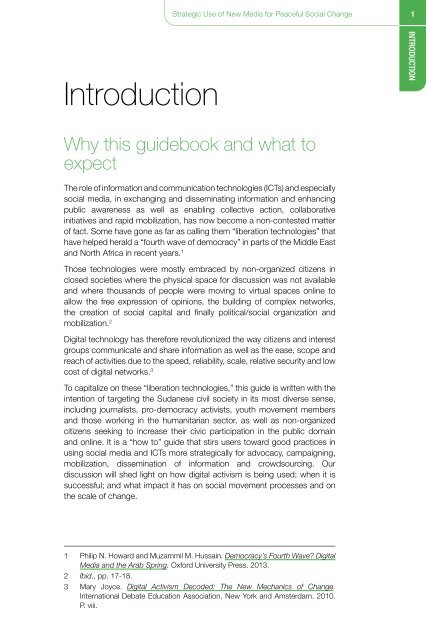Strategic Use New Media Peaceful Social Change
1Uy7LZ0
1Uy7LZ0
Create successful ePaper yourself
Turn your PDF publications into a flip-book with our unique Google optimized e-Paper software.
<strong>Strategic</strong> <strong>Use</strong> of <strong>New</strong> <strong>Media</strong> for <strong>Peaceful</strong> <strong>Social</strong> <strong>Change</strong> 1<br />
Introduction<br />
INTRODUCTION<br />
Why this guidebook and what to<br />
expect<br />
The role of information and communication technologies (ICTs) and especially<br />
social media, in exchanging and disseminating information and enhancing<br />
public awareness as well as enabling collective action, collaborative<br />
initiatives and rapid mobilization, has now become a non-contested matter<br />
of fact. Some have gone as far as calling them “liberation technologies” that<br />
have helped herald a “fourth wave of democracy” in parts of the Middle East<br />
and North Africa in recent years. 1<br />
Those technologies were mostly embraced by non-organized citizens in<br />
closed societies where the physical space for discussion was not available<br />
and where thousands of people were moving to virtual spaces online to<br />
allow the free expression of opinions, the building of complex networks,<br />
the creation of social capital and finally political/social organization and<br />
mobilization. 2<br />
Digital technology has therefore revolutionized the way citizens and interest<br />
groups communicate and share information as well as the ease, scope and<br />
reach of activities due to the speed, reliability, scale, relative security and low<br />
cost of digital networks. 3<br />
To capitalize on these “liberation technologies,” this guide is written with the<br />
intention of targeting the Sudanese civil society in its most diverse sense,<br />
including journalists, pro-democracy activists, youth movement members<br />
and those working in the humanitarian sector, as well as non-organized<br />
citizens seeking to increase their civic participation in the public domain<br />
and online. It is a “how to” guide that stirs users toward good practices in<br />
using social media and ICTs more strategically for advocacy, campaigning,<br />
mobilization, dissemination of information and crowdsourcing. Our<br />
discussion will shed light on how digital activism is being used; when it is<br />
successful; and what impact it has on social movement processes and on<br />
the scale of change.<br />
1 Philip N. Howard and Muzammil M. Hussain. Democracy’s Fourth Wave? Digital<br />
<strong>Media</strong> and the Arab Spring. Oxford University Press. 2013.<br />
2 Ibid., pp. 17-18.<br />
3 Mary Joyce. Digital Activism Decoded: The <strong>New</strong> Mechanics of <strong>Change</strong>.<br />
International Debate Education Association, <strong>New</strong> York and Amsterdam. 2010.<br />
P. viii.


